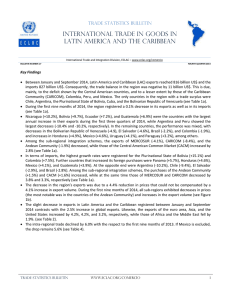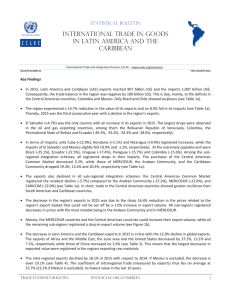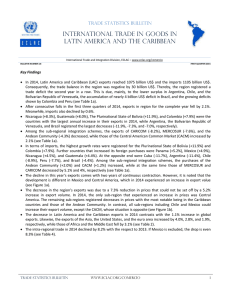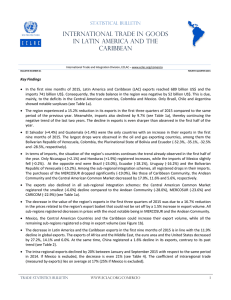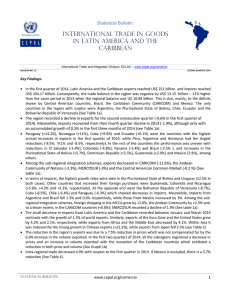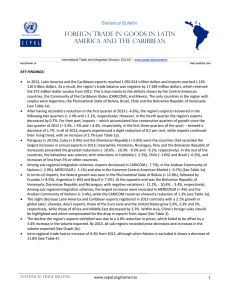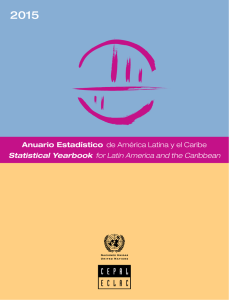bulletin_fourth_quarter_2013_no13 PDF | 918.5 Kb
Anuncio
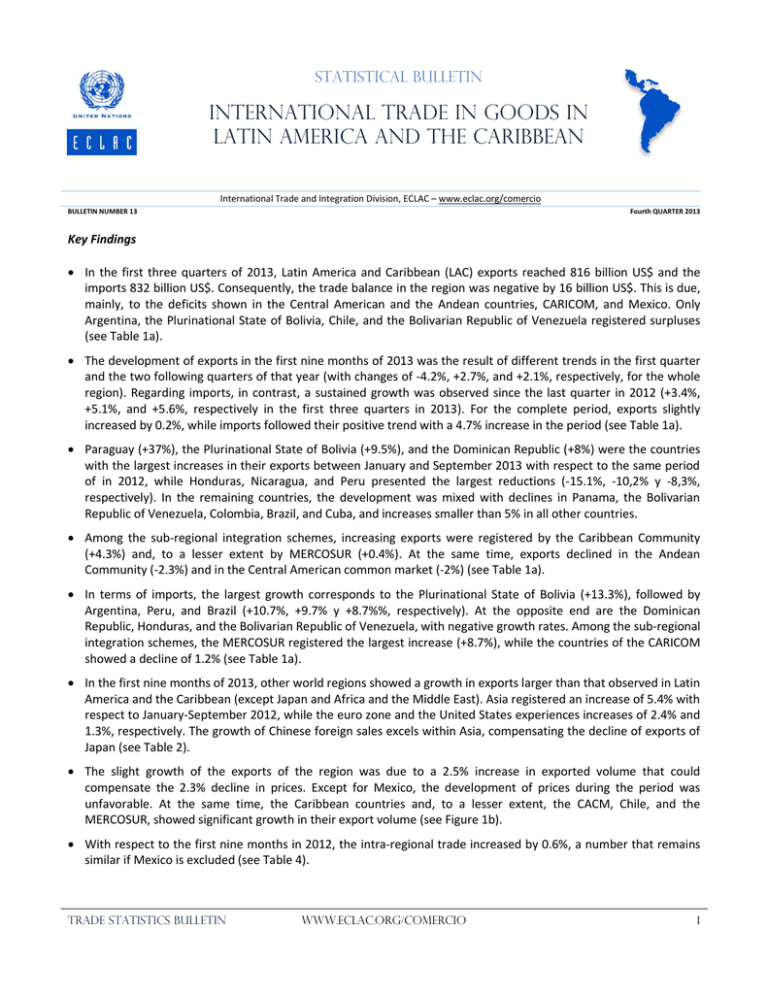
Statistical Bulletin International Trade in Goods in Latin America and the Caribbean International Trade and Integration Division, ECLAC – www.eclac.org/comercio BULLETIN NUMBER 13 Fourth QUARTER 2013 Key Findings In the first three quarters of 2013, Latin America and Caribbean (LAC) exports reached 816 billion US$ and the imports 832 billion US$. Consequently, the trade balance in the region was negative by 16 billion US$. This is due, mainly, to the deficits shown in the Central American and the Andean countries, CARICOM, and Mexico. Only Argentina, the Plurinational State of Bolivia, Chile, and the Bolivarian Republic of Venezuela registered surpluses (see Table 1a). The development of exports in the first nine months of 2013 was the result of different trends in the first quarter and the two following quarters of that year (with changes of -4.2%, +2.7%, and +2.1%, respectively, for the whole region). Regarding imports, in contrast, a sustained growth was observed since the last quarter in 2012 (+3.4%, +5.1%, and +5.6%, respectively in the first three quarters in 2013). For the complete period, exports slightly increased by 0.2%, while imports followed their positive trend with a 4.7% increase in the period (see Table 1a). Paraguay (+37%), the Plurinational State of Bolivia (+9.5%), and the Dominican Republic (+8%) were the countries with the largest increases in their exports between January and September 2013 with respect to the same period of in 2012, while Honduras, Nicaragua, and Peru presented the largest reductions (-15.1%, -10,2% y -8,3%, respectively). In the remaining countries, the development was mixed with declines in Panama, the Bolivarian Republic of Venezuela, Colombia, Brazil, and Cuba, and increases smaller than 5% in all other countries. Among the sub-regional integration schemes, increasing exports were registered by the Caribbean Community (+4.3%) and, to a lesser extent by MERCOSUR (+0.4%). At the same time, exports declined in the Andean Community (-2.3%) and in the Central American common market (-2%) (see Table 1a). In terms of imports, the largest growth corresponds to the Plurinational State of Bolivia (+13.3%), followed by Argentina, Peru, and Brazil (+10.7%, +9.7% y +8.7%%, respectively). At the opposite end are the Dominican Republic, Honduras, and the Bolivarian Republic of Venezuela, with negative growth rates. Among the sub-regional integration schemes, the MERCOSUR registered the largest increase (+8.7%), while the countries of the CARICOM showed a decline of 1.2% (see Table 1a). In the first nine months of 2013, other world regions showed a growth in exports larger than that observed in Latin America and the Caribbean (except Japan and Africa and the Middle East). Asia registered an increase of 5.4% with respect to January-September 2012, while the euro zone and the United States experiences increases of 2.4% and 1.3%, respectively. The growth of Chinese foreign sales excels within Asia, compensating the decline of exports of Japan (see Table 2). The slight growth of the exports of the region was due to a 2.5% increase in exported volume that could compensate the 2.3% decline in prices. Except for Mexico, the development of prices during the period was unfavorable. At the same time, the Caribbean countries and, to a lesser extent, the CACM, Chile, and the MERCOSUR, showed significant growth in their export volume (see Figure 1b). With respect to the first nine months in 2012, the intra-regional trade increased by 0.6%, a number that remains similar if Mexico is excluded (see Table 4). TRADE Statistics BULLETIN www.eclac.org/comercio 1 A – Trade by Origin and Destination Table 1. Latin America and the Caribbean: Trends in Goods Exports. (Millions of current US$ and change rates in percentages) a) Accumulated, January – September 2013 Argentina Bolivia, Plurinational State Brazil Chile Colombia Costa Rica Cuba Ecuador El Salvador Guatemala Honduras Mexico Nicaragua Panama Paraguay Peru Dominican Republic Uruguay Venezuela, Bolivarian Republic Latin America and the Caribbean Andean Community (CAN) Caribbean Community (CARICOM) Central American Common Market (CACM) Southern Common Market (MERCOSUR) Jan-Sep 2012 61 852 8 339 180 596 57 109 44 374 8 533 1 773 18 164 4 059 7 614 3 572 275 153 2 038 243 5 529 33 899 6 712 6 689 72 782 813 721 104 775 14 691 25 816 254 666 Exports Jan-Sep 2013 63 479 9 131 177 650 57 876 43 485 8 594 1 769 18 622 4 216 7 634 3 034 281 311 1 830 228 7 575 31 078 7 248 6 999 68 538 815 627 102 316 15 329 25 308 255 704 Change 2.6 9.5 -1.6 1.3 -2.0 0.7 -0.2 2.5 3.9 0.3 -15.1 2.2 -10.2 -6.0 37 -8.3 8.0 4.6 -5.8 0.2 -2.3 4.3 -2.0 0.4 Jan-Sep 2012 50 910 5 455 164 886 54 558 43 767 12 950 6 267 19 024 7 709 12 622 7 024 273 263 4 306 8 979 7 839 29 771 11 169 8 722 45 275 794 055 98 017 19 558 44 611 232 358 Imports Jan-Sep 2013 56 337 6 180 179 260 56 088 44 116 13 442 6 676 20 621 8 138 13 129 6 680 284 188 4 172 9 595 8 436 32 670 10 154 8 615 43 744 831 560 103 587 19 318 45 561 252 649 Change 10.7 13.3 8.7 2.8 0.8 3.8 6.5 8.4 5.6 4.0 -4.9 4.0 -3.1 6.9 7.6 9.7 -9.1 -1.2 -3.4 4.7 5.7 -1.2 2.1 8.7 b) Exports, October 2012 – September 2013 Argentina Bolivia, Plurinational State Brazil Chile Colombia Costa Rica Cuba Ecuador El Salvador Guatemala Honduras Mexico Nicaragua Panama Paraguay Peru Dominican Republic Uruguay Venezuela, Bolivarian Republic Latin America and the Caribbean CAN CARICOM CACM MERCOSUR Oct-12 6 897 1 097 21 763 7 445 4 985 905 225 1 946 445 733 276 33 918 234 9 630 3 782 772 681 7 527 Nov-12 6 463 1 031 20 472 6 575 4 732 949 179 1 778 417 808 250 31 438 199 9 600 3 709 890 664 7 877 Dec-12 5 993 1 066 19 748 7 280 4 933 860 145 1 990 418 824 323 30 174 206 9 522 3 953 695 676 7 877 Jan-13 5 665 1 124 15 967 6 967 4 735 897 194 1 939 478 828 380 27 299 217 18 649 3 424 700 537 8 311 Feb-13 5 743 824 15 549 5 727 4 668 919 164 2 082 436 796 358 29 146 188 17 746 3 183 736 527 7 240 Mar-13 5 968 1 054 19 320 6 328 4 567 986 125 2 201 448 982 381 31 881 222 25 838 3 638 819 612 7 730 Apr-13 7 565 1 008 20 631 6 812 4 949 989 226 1 934 489 888 355 32 861 231 26 918 3 179 824 713 7 760 May-13 8 429 1 015 21 822 7 027 5 267 999 216 2 055 520 966 353 32 836 208 26 976 3 472 927 988 7 577 Jun-13 7 551 1 008 21 134 6 354 4 820 961 172 1 983 451 808 320 31 025 197 26 920 3 251 776 1 002 7 689 Jul-13 7 828 1 046 20 807 6 411 4 650 947 272 2 130 491 827 308 32 212 196 31 908 3 318 857 884 7 410 Aug-13 7 735 1 047 21 424 6 395 4 978 927 179 2 102 478 805 288 32 668 191 31 924 4 076 826 934 7 410 Sep-13 6 995 1 005 20 996 5 855 4 851 969 221 2 195 425 733 290 31 385 182 31 697 3 537 782 803 7 410 96 642 91 314 89 204 82 256 80 585 89 957 94 194 97 336 92 094 93 270 95 176 90 759 11 810 2 371 2 593 29 971 11 250 2 274 2 623 28 199 11 941 1 513 2 631 26 939 11 222 1 928 2 800 22 817 10 757 1 536 2 698 22 565 11 460 1 832 3 019 26 738 11 071 1 834 2 952 29 827 11 809 1 659 3 045 32 216 11 063 1 645 2 738 30 606 11 144 1 738 2 769 30 426 12 203 1 758 2 689 31 017 11 587 1 397 2 599 29 491 TRADE Statistics BULLETIN www.eclac.org/comercio 2 c) Imports, October 2012 – September 2013 Argentina Bolivia, Plurinational State Brazil Chile Colombia Costa Rica Cuba Ecuador El Salvador Guatemala Honduras Mexico Nicaragua Panama Paraguay Peru Dominican Republic Uruguay Venezuela, Bolivarian Republic Latin America and the Caribbean Oct-12 6 312 742 20 104 7 897 5 219 1 616 752 2 037 864 1 532 814 35 565 539 1 074 1 002 3 640 1 271 1 057 4 961 Nov-12 5 829 720 20 659 6 237 5 167 1 551 762 2 076 862 1 431 805 32 716 467 1 079 964 3 492 1 246 927 5 192 Dec-12 5 464 776 17 500 6 219 4 480 1 473 761 2 017 835 1 410 862 29 208 538 1 089 951 3 039 1 279 946 5 192 Jan-13 5 385 706 20 007 6 637 5 201 1 563 742 2 281 915 1 465 807 30 153 426 1 020 1 004 3 877 1 022 895 5 478 Feb-13 5 222 567 16 828 5 781 4 497 1 354 761 2 123 802 1 337 726 29 066 460 946 884 3 236 1 182 839 4 772 Mar-13 5 458 688 19 158 5 702 4 488 1 474 756 2 214 825 1 346 679 30 128 402 1 142 873 3 355 1 103 916 5 095 Apr-13 6 414 710 21 620 6 388 5 167 1 606 749 2 249 947 1 610 738 34 088 493 1 100 1 056 3 591 1 102 992 5 115 May-13 7 091 735 21 061 6 685 5 181 1 488 757 2 499 957 1 596 714 33 306 466 1 100 936 3 863 1 141 1 018 4 994 Jun-13 6 396 576 18 826 5 777 4 311 1 392 778 2 228 961 1 382 710 30 168 479 1 100 828 3 320 1 160 828 5 068 Jul-13 7 058 709 22 706 6 568 5 148 1 538 745 2 277 967 1 532 804 33 651 491 1 063 923 3 869 1 184 988 4 407 Aug-13 7 167 798 20 201 6 697 4 975 1 525 683 2 550 934 1 387 767 32 902 510 1 063 965 4 024 1 177 1 011 4 407 Sep-13 6 146 691 18 855 5 853 5 148 1 502 703 2 199 831 1 474 733 30 726 445 1 063 966 3 536 1 084 1 129 4 407 99 246 94 198 86 155 91 579 83 614 88 087 97 774 97 514 88 517 98 638 96 045 89 792 CAN 11 638 11 455 10 313 12 065 10 423 10 745 11 717 12 278 10 435 12 003 12 347 11 574 CARICOM 2 249 2 015 2 114 1 994 2 231 2 285 2 040 1 926 2 228 2 010 2 302 2 301 CACM 5 364 5 116 5 119 5 176 4 679 4 726 5 394 5 222 4 925 5 333 5 123 4 984 MERCOSUR 28 475 28 379 24 861 27 291 23 773 26 405 30 081 30 105 26 879 31 674 29 344 27 096 Source: ECLAC based on data from Statistical Offices, Central Banks, Export Promotion Agencies, the United States International Trade Commission (USITC), EUROSTAT of the European Union, Statistics Canada, the International Monetary Fund Direction of Trade Statistics (DOTS), and the Central American Monetary Council. Notes: Data for the Bolivarian Republic of Venezuela are quarterly and estimated through applying the monthly DOTS trends. Data for Cuba and the CARICOM countries are estimated based on mirror statistics. Data for Honduras and Nicaragua do not include maquila. Data for the Dominican Republic for the period May to June are estimated. Data of Panama for 2013 are estimated. Figure 1. Latin America and the Caribbean: Trends in Exports, January – September 2013 a) Change compared to previous year (in %) Caribbean Countries 0.4 2.2 Mexico -2.0 Central America Chile Andean Community MERCOSUR South America b) 10.2 Jan-Sep 2013 0 5 8.5 -1.7 MERCOSUR -3.6 South America -3.2 15 Jan-Sep 2012 -0.6 4.0 2.2 -2.3 Latin America and the Caribbean 10 6.3 -5.0 Andean Community 0.2 1.4 Latin America and the Caribbean -10.4 Chile 0.4 15.2 0.6 1.6 Central America 1.3 -4.1 -1.0 -1.2 -5.0 Mexico 5.5 -5 Caribbean Countries 6.2 4.6 -6.1 -2.3 -10 Decomposition of change in price and volume compared to previous year (in %) -20 -10 Price 2.5 0 10 20 Volume Source: ECLAC based on data from Statistical Offices, Central Banks, Export Promotion Agencies, USITC, EUROSTAT, and DOTS. Notes: Data for the Bolivarian Republic of Venezuela are quarterly and estimated through applying the monthly DOTS trends. Data for Cuba and the CARICOM countries are estimated based on mirror statistics. Cuba’s deflator is built based on the volume imported by the European Union; the Caribbean’s deflator is built based on the deflators reported by Guyana and Jamaica to the IMF. CACM data do not include maquila for Honduras and Nicaragua. In the first nine months of 2013, the 0.2% growth of the exports in the region was due to the 2.5% increase in export volumen that compensated the 2.3% reduction in prices. Within the sub-regions, the largest declines in prices were observed in the CACM (-10.4%) and in the Caribbean countries (-5%). In terms of export volume, the Andean Community registered a 7.5% decline, while the Caribbean countries, the CACM, Chile, and MERCOSUR showed increases in the pis period (15.2%, 8.5%, 6.3%, y 4.0%, respectively) (see Figure 1b). TRADE Statistics BULLETIN www.eclac.org/comercio 3 Figure 2 and Table 2. Latin America and the Caribbean and Selected Regions: Trends in Value of Exports, January 2006 – September 2013 Latin America and Caribbean Exports: Main Destinations (January 2006 index =100) 1200 1000 Growth Compared to Other Regions (Accumulated to September each year, in percentages) United States Latin America and the Caribbean Africa and the Middle East Asia China Japan Euro area United States World European Union Other Asia 800 600 China Latin America and the Caribbean 400 200 Growth J-S 2011 26.9 33.5 22.5 22.7 9.1 21.5 17.6 23.0 Growth J-S 2012 1.4 2.1 2.4 7.4 -0.8 -5.3 5.6 -0.4 Growth J-S 2013 0.2 -4.2 5.4 8.0 -12.2 2.4 1.3 1.3 0 Source: ECLAC based on data from Statistical Offices, Central Banks, Export Promotion Agencies, USITC, EUROSTAT, Statistics Canada, DOTS, and CPB Netherlands Bureau for Economic Policy Analysis. Notes: Data for the Bolivarian Republic of Venezuela are quarterly and estimated through applying the monthly DOTS trends. Data for Cuba and CARICOM are estimated based on mirror statistics. Figure 2 does not include Panama and the Dominican Republic; it does also not include maquila for Honduras and Nicaragua. Between January and September 2013, the main export destinations of Latin America and the Caribbean were the United States (39.6%), Asia (19.9%), and the region itself (18.4%). As regards imports, the United States also was the main source (30.2%), followed by Asia (27.2%), and the region itself (18.6%) (see Table 3). Table 3. Latin America and the Caribbean: Trade with Main Partners, October 2012 – September 2013 (Millions of current US$) Exports United States European Union Asia China Other Asia Latin America and the Caribbean Rest of the World Oct-12 95 860 38 078 11 570 17 230 7 333 9 897 18 716 10 266 Nov-12 90 415 36 175 10 865 15 952 6 380 9 573 17 840 9 583 Dec-12 88 500 35 639 9 604 17 747 8 149 9 598 15 766 9 744 Jan-13 81 538 33 427 9 717 13 999 6 271 7 728 14 919 9 475 Feb-13 79 832 32 721 9 412 13 978 5 640 8 339 15 072 8 649 Mar-13 89 114 35 739 10 016 17 214 8 265 8 949 15 920 10 225 Apr-13 93 343 37 554 10 910 18 543 9 594 8 949 16 423 9 914 May-13 96 383 36 951 10 996 21 230 11 601 9 629 17 483 9 722 Jun-13 91 293 35 162 10 281 18 977 9 860 9 117 17 721 9 152 Jul-13 92 382 36 943 11 045 18 398 8 450 9 949 16 848 9 149 Aug-13 94 319 36 823 11 215 19 753 10 401 9 352 16 974 9 554 Sep-13 89 946 34 558 10 894 18 339 9 341 8 998 16 967 9 187 Share % 100.0 39.6 11.7 19.9 9.8 10.0 18.4 10.5 Imports 96 901 91 872 83 786 89 537 81 486 85 842 95 573 95 273 86 258 96 392 93 805 87 646 100.0 United States 30 209 28 463 26 564 27 534 25 279 27 061 29 012 27 776 25 477 28 108 28 501 26 817 30.2 European Union 13 485 13 107 11 295 12 901 11 212 12 448 14 044 14 136 12 625 13 986 13 983 12 362 14.5 Asia 27 223 25 022 21 959 24 471 22 152 22 109 24 983 25 563 23 547 27 117 26 159 24 632 27.2 China 15 429 13 757 12 553 13 425 12 396 11 898 12 791 13 625 12 798 15 051 14 735 14 361 14.9 Other Asia 11 794 11 266 9 406 11 045 9 756 10 211 12 192 11 937 10 749 12 066 11 424 10 270 12.3 Latin America and the Caribbean 19 434 18 302 16 764 16 449 15 534 15 982 17 867 17 905 16 248 17 236 17 561 16 566 18.6 Rest of the World 6 549 6 978 7 204 8 182 7 310 8 242 9 665 9 893 8 361 9 945 7 601 7 269 9.4 Source: ECLAC based on data from Statistical Offices, Central Banks, Export Promotion Agencies, USITC, EUROSTAT, Statistics Canada, and DOTS. Notes: Includes data from Argentina, the Plurinational State of Bolivia, Brazil, Chile, Colombia, Costa Rica, Cuba, Ecuador, El Salvador, Guatemala, Honduras, Mexico, Nicaragua, Paraguay, Peru, Uruguay, the Bolivarian Republic of Venezuela, and CARICOM. It does not include maquila for Honduras and Nicaragua. Data for Cuba and CARICOM are estimated based on mirror statistics of the United States, the European Union, Canada, and the rest of Latin America. In the case of the Bolivarian Republic of Venezuela, the total was disaggregated utilizing mirror statistics from the United States, the European Union, Japan, Chile, and Colombia; DOTS structure was used for the rest of the destinations. In the first three quarters of 2013, the exports to the European Union and to the United States decreased by 4.8% and 0.8%, respectively, with respect to the same period in 2012. Sales to Asia continued with the same dynamics observed since the end of 2012 and increased by 7.2%. Exports to the region itself increased by 0.6%. At the imports side, the largest increases are observed in those coming from the European Union (+7.6%) and Asia (+5.5). TRADE Statistics BULLETIN www.eclac.org/comercio 4 Up to September 2013, the largest share of intra-regional trade was observed in the Central American Common Market (25.5%), the only sub-region whose coefficient lay above the aggregated one for whole Latin America and the Caribbean (18.9%). The Andean Community (CAN) remains the grouping with the lowest coefficient of intra-subregional trade (7.8%). Moreover, the negative growth recorded for intra-CAN and the trade of Venezuela and Mexico with the region should be noted (see Table 4). The intra-regional trade grew at a rate of 0.6% and the exports of the region by 0.2%. Table 4. Latin America: Intra-Subregional and Intra-Regional Trade, October 2012 – September 2013 (Percentages of total exports and change rates) Oct-12 Nov-12 Dec-12 Jan-13 Feb-13 Mar-13 Apr-13 May-13 Jun-13 Intra CAN 8.2 8.0 6.7 6.4 8.1 7.7 8.0 7.2 7.4 Intra CACM 23.5 24.3 22.5 22.4 23.4 21.1 21.7 22.9 23.9 Intra MERCOSUR 15.2 15.7 15.4 17.0 17.3 15.4 15.1 14.3 14.1 Chile to LAC 18.1 17.8 15.9 16.3 15.7 17.8 16.1 18.1 18.8 Mexico to LAC 7.3 6.8 6.5 6.6 6.8 7.4 7.3 7.5 7.7 Venezuela, B.R., to LAC 13.6 12.2 13.4 12.2 16.9 15.1 14.6 15.5 15.1 Intra LAC 19.5 19.7 17.8 18.3 18.9 17.9 17.6 18.1 19.4 Intra LAC w/o Mexico 20.1 20.8 18.8 19.7 20.2 18.3 17.9 18.5 20.1 Source: ECLAC based on data from Statistical Offices, Central Banks, Export Promotion Agencies, USITC, EUROSTAT, and DOTS. Note: It does not include maquila for Honduras and Nicaragua. MERCOSUR data include the Bolivarian Republic of Venezuela. a Growth rates with respect to the same period of the previous year. Jul-13 7.9 24.3 15.2 19.1 7.6 12.7 18.2 23.9 Aug-13 6.2 23.7 14.7 19.6 7.9 16.1 18 23.3 Change a Sep-13 J-S 13/J-S 12 7.8 -2.0 25.5 6.3 15.3 9.6 18.5 2.4 7.7 -3.7 16.0 -7.5 18.9 0.6 24.8 0.6 B – Trade by Category and Main Products Table 5. Latin America and the Caribbean: Main Traded Product Categories, October 2012 – September 2013 (Millions of current US$) EXPORTS Agriculture and Livestock Mining and Petroleum Manufactures Oct-12 94 761 11 639 29 812 53 309 Nov-12 89 512 10 750 29 153 49 608 Dec-12 88 235 10 417 30 870 46 948 Jan-13 78 962 11 103 26 208 41 651 Feb-13 78 833 10 110 25 375 43 347 Mar-13 87 514 11 203 26 578 49 733 Apr-13 91 642 12 318 26 597 52 727 May-13 95 078 12 296 27 670 55 112 Jun-13 89 989 10 794 26 194 53 001 Jul-13 91 046 10 963 26 730 53 353 Aug-13 93 032 11 354 27 893 53 786 Sep-13 Part. % 88 939 100.0 10 047 12.6 28 081 30.4 50 811 57.0 IMPORTS 96 516 91 122 83 380 87 180 79 692 83 641 93 298 93 283 83 818 94 498 91 720 85 402 100.0 Capital Goods 18 198 17 071 16 883 16 666 14 713 15 137 16 557 16 551 15 017 16 652 15 915 14 856 17.9 Intermediate Inputs 47 532 42 926 39 830 40 658 39 062 40 455 44 798 45 937 41 609 46 324 45 565 42 927 48.9 Consumption Goods 18 701 17 847 16 229 16 278 15 020 16 315 17 815 16 895 15 825 17 682 17 982 17 037 19.0 Fuels 12 085 13 277 10 438 13 578 10 896 11 733 14 128 13 900 11 367 13 840 12 258 10 583 14.2 Source: ECLAC based on data from Statistical Offices, Central Banks, Export Promotion Agencies, USITC, and EUROSTAT. Note: Includes data from Argentina, the Plurinational State of Bolivia, Brazil, Chile, Colombia, Costa Rica, Ecuador, El Salvador, Guatemala, Honduras, Mexico, Nicaragua, Panama, Paraguay, Peru, the Dominican Republic, Uruguay, and the Bolivarian Republic of Venezuela. It does not include maquila for Honduras and Nicaragua. By product categories, the largest changes between January and September 2013 with respect to the previous year were registered in the exports of agriculture and livestock (+23.6%) and mining and petroleum (-7.3%). Manufactured goods that alone accounted for the majority of total exports increased by 2.4%. The decline in export value can be mainly explained by the change in minerals and oil, which together represent about 30% of the total exports. Likewise, the Latin American commodities price index fell by 3.3% in the first three months of this year (see Table 6.b), with declines in nearly all products (especially beverages and sugar). In terms of export volume, the sharp declines registered by gas and iron, as well as the increases registered by soy and sugar (see Table 6a). TRADE Statistics BULLETIN www.eclac.org/comercio 5 Table 6. Latin America and the Caribbean: Main Products Exported, January – September 2013 (Millions of current US$, percentages and price indices 2000=100) a) Selected Products b) Product Groups Value Prices Volume Prices Jan-Sep Jan-Sep Value Sep Jan-Sep Jan-Sep Price change Jan-Sep Jan-Sep Price Sep (E) 2012 2013 change 2013 2012 2013 change 2012 2013 change 2013 Sugar 2% 10 451 11 435 9.4 212.8 271.1 216.6 -20.1 29.5 Foodstuff 10% 171.5 167.5 -2.3 165.9 Banana 1% 2 739 2 999 9.5 223.9 237.6 220.7 -7.1 16.6 Beverages 3% 177.9 129.7 -27.1 123.7 Beverages (A) 3% 8 355 6 772 -18.9 115.8 177.9 129.7 -27.1 8.1 Oils and 8% Meats 2% 16 255 17 574 8.1 199.9 213.4 209.5 -1.8 9.9 flours 215.8 207.4 -3.9 206.0 Copper 9% 39 958 39 071 -2.2 394.7 439.2 407.2 -7.3 5.1 Other agro 9% 151.1 152.0 0.6 153.7 Gas 2% 5 468 6 111 11.8 83.8 58.9 85.5 45.3 -33.6 Minerals and 27% 248.4 239.8 -3.4 215.9 Iron-Steel (B) 5% 12 861 10 437 -18.8 485 473.5 489.8 3.4 -22.3 metals Oil 30% 134 626 128 122 -4.8 405.5 395.3 387.4 -2.0 -2.8 Fuels 45% 181.8 177.5 -2.4 183.0 Soy (C) 3% 22 262 29 571 32.8 262.5 277.2 255.6 -7.8 40.6 Sub-total 57% 252 975 252 092 -0.3 206.8 210.8 203.2 -3.6 3.2 Total 100% 198.4 191.9 -3.3 183.3 Source: ECLAC based on data from Statistical Offices, Central Banks, Export Promotion Agencies, CEPALSTAT and the World Bank. See description in the Annex in Excel. Notes: Product statistics are made up by main exporters in the region and not with all countries; in each case, they represent more than 70% of the annual total in that product. In the case of prices, it is an index calculated by ECLAC. (A) Average of coffee, tea, and yerba mate; (B) Made up of iron and steel manufactures; (C) Soy grains; (D) Weight of each product in the total regional exports; (E) Weight of each group in natural resources and manufacturing exports in the region. Products (D) Recent Activities of the International Trade and Integration Division Publications Promoción del comercio y la inversión con China: desafíos y oportunidades en la experiencia de las cámaras empresariales latinoamericanas La cooperación entre América Latina y la Unión Europea: una asociación para el desarrollo Panorama de la inserción internacional de América Latina y el Caribe 2013 Strengthening biregional cooperation between Latin America and Asia-Pacific: the role of FEALAC Comercio internacional y desarrollo inclusivo. Construyendo sinergias Documento de discusión para el seminario Cooperación para el desarrollo CELAC-Unión Europea: Desafíos post 2015 Huella de carbono y exportaciones de alimentos. Guía práctica Panorama de la inserción internacional de América Latina y el Caribe 2011-2012 La República Popular China y América Latina y el Caribe: Diálogo y cooperación ante los nuevos desafíos de la economía global China y América Latina y el Caribe Hacia una relación económica y comercial estratégica Effects of trade opening on household welfare: the Chilean case El pilar de cooperación en el acuerdo de asociación política, económica y de cooperación entre Chile y la Unión Europea India and Latin America and the Caribbean. Opportunities and challenges in trade and investment relations. Manual de comercio exterior y política comercial. Nociones básicas, clasificaciones e indicadores de posición y dinamismo. Events TALLER REGIONAL: "Bases de datos para identificar y caracterizar a las pymes exportadoras" Seminario: "La asociación estratégica entre la Unión Europea y América Latina" Reunión de Expertos: Facilitando la efectiva integración de países en desarrollo en la economía global a través de programas de Ayuda para el Comercio Seminario internacional: "Cadenas de valor globales y regionales: experiencias Asia y América Latina" Diálogo regional sobre la promoción del desarrollo y el comercio de servicios en América Latina y el Caribe Seminario internacional: "Facilitando la efectiva integración de los países en desarrollo a la Economía Global a través de Programas de Ayuda para el Comercio" Seminario "Competitividad y Cadenas de Valor en América Latina" Seminario “Semana Asia” Taller de Huella de Carbono para productos de exportación, sector alimentos, de América Latina: prácticas empresariales. Curso Indicadores de Comercio Exterior y Política Comercial Seminario "Haciendo negocios con China: Experiencias de América Latina" Curso de Estadísticas y Econometría aplicada al comercio This document, which has not been submitted to formal editing, was prepared by the International Trade and Integration Division at the Economic Commission for Latin America and the Caribbean (ECLAC). Copyright © United Nations, 2013. All rights reserved. TRADE Statistics BULLETIN www.eclac.org/comercio 6
